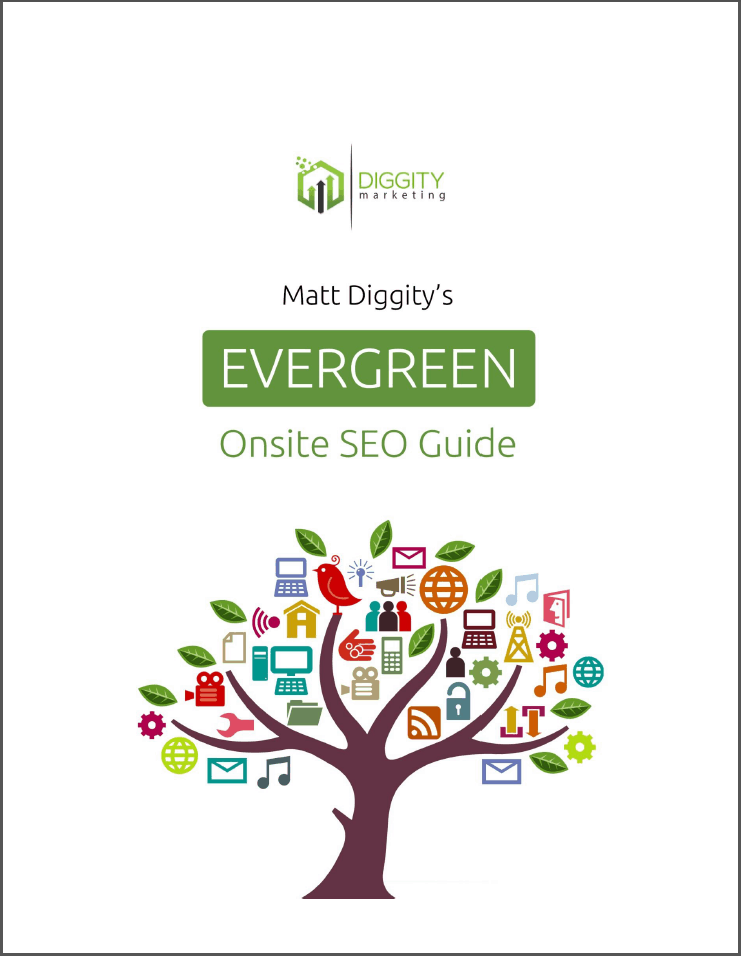
As someone who has worked with various hosting platforms over the years, I understand the importance of choosing the right one for your project. Amazon’s pay-as-you-go model is ideal for anyone starting off with a low budget and wanting a scalable aws infrastructure that can take their project to new heights.
But, many developers avoid Amazon Web service (AWS) cloud hosting platforms because they find the pricing too confusing.
No matter if you’re thinking of using Amazon web service resources and media for data storage, data processing with computing tools, or as a hosting solution, it’s critical to learn about Amazon web service. From my experience, having a clear grasp of the costs can save you from unexpected surprises on your monthly bill.
We’ve demystified the resources and media costs below so you know what kind of bill to expect each month. So let’s take a look at the real costs of using Amazon services.
Table Of Contents
- Simplifying AWS’s Pricing
- Understanding The Terminology
- Utilizing Billing & Tagging To Track Your AWS Costs
- Costs For Amazon Lightsail
- Costs For Compute Instances: Amazon EC2 (Elastic Compute Cloud)
- Costs For AWS Databases
- Static File Storage: Costs For Amazon S3
- AWS Amplify Pricing
- Cost Breakdown & Variability
- AWS Pricing Calculators
- Recommended Alternatives
- Frequently Asked Questions (FAQS)
- Summary Of AWS Costs You Can Expect Each Month
Simplifying AWS’s Pricing
Amazon web services pricing varies based on the resources and media you use. The only web service that Amazon offers with fixed packages and pricing is Amazon Lightsail.

While AWS cloud web services can be used for numerous computing purposes, we’ve evaluated some of the most popular resources and media services for hosting websites and apps of various sizes, including:
Amazon Lightsail
Amazon EC2
AWS Databases
Amazon S3
AWS Amplify
The key to predicting your AWS resources and media costs each month comes down to keeping an eye on what resources and media you’re using.
Learn about Amazon web service to take advantage of special resources for Amazon web service and discounts or reserve a cloud instance for between one and three years.
If you’re just starting out, you can also take a look at the Amazon web service free tier to help you get started. The free tier gives you a feel for the cloud and its various resources and media.
With a free tier, you get access to a range of resources and media products with no upfront costs or long-term commitments. You get access to the best of Amazon web service, including Amazon virtual private cloud
storage, databases, analytics, application services, deployments, and security, with no financial risk.
Amazon web service free tier is a chance to experiment, innovate, and gain valuable experience with AWS cloud at any time.
Understanding The Terminology
If you’re just starting out, you might find all of the terminology is a blocker to your understanding of what the Amazon web services includes and what resources and media you’ll need.

Is reserved, on-demand or a spot instance better for your project?
What about a savings plan for resources for Amazon web service?
It can feel like you’re in way over your head and not sure how much resources for Amazon web service will end up costing simply because of all the technical jargon used.
It’s outside the scope of this article to dig into all of these terms right now but you can check out these resources and media to get you started:
The Official AWS Glossary: A full list of all terms
Data Flair’s AWS Glossary: A Quick Guide of the mostly used AWS Terms
Utilizing Billing & Tagging To Track Your AWS Costs
Once you start using AWS resources and media, you’ll need to keep a close eye on where your money is going within the AWS platform.
You can easily achieve this by using the tagging function that most AWS services include.
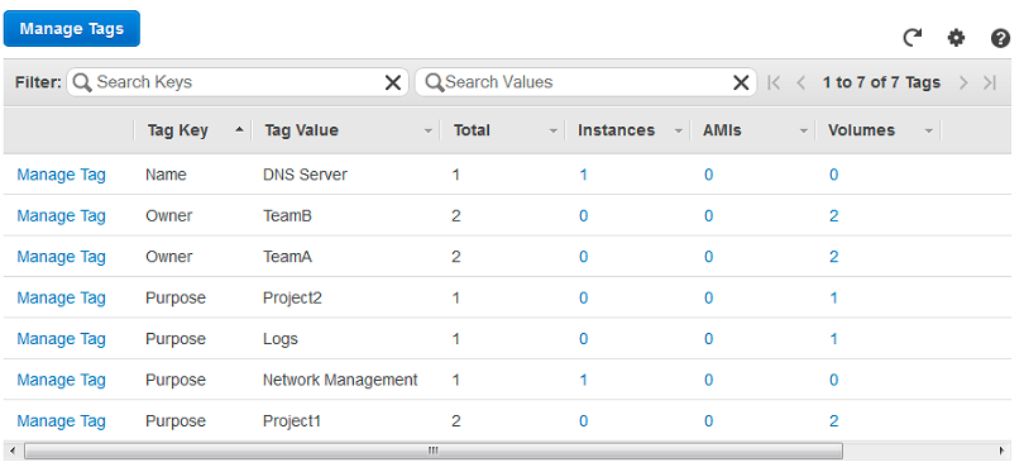
It’s as simple as creating a tag for each of your projects.
When you check the AWS Cost Explorer, you’ll then be able to see a cost breakdown for the web services and how much of the total cost was attributed to each of your projects.
Without using these resources and media functionality, you’ll have no idea if you’re overspending on AWS resources for certain projects.
With that said, let’s start breaking down the costs for Amazon web services.
Costs For Amazon Lightsail
If you’re using a common CMS like WordPress, Drupal, or Magento and you’re looking for enterprise-grade Amazon web service virtual private cloud hosting, Amazon Lightsail is worth checking out for your Amazon web.

It has over 84 available resources and media zones covering 26 regions and 245 countries around the world.
Like many other cloud hosting providers, you can choose between Linux or Windows servers and the final costs will vary depending on the resources and media included in your plan.
| Memory | Monthly Cost (USD) | vCPU Cores | SSD Storage | Data Transfer | Operating System |
| 512 MB | $3.50 | 1 | 20 GD | 1 TB | Linux/Unix |
| 1 GB | $5 | 1 | 40 GB | 2 TB | Linux/Unix |
| 2 GB | $10 | 1 | 60 GB | 3 TB | Linux/Unix |
| 4 GB | $20 | 2 | 80 GB | 4 TB | Linux/Unix |
| 8 GB | $40 | 2 | 160 GB | 5 TB | Linux/Unix |
| 16 GB | $80 | 4 | 320 GB | 6 TB | Linux/Unix |
| 32 GB | $160 | 8 | 640 GB | 7 TB | Linux/Unix |
| 512 MB | $8 | 1 | 30 GB | 1 TB | Windows |
| 1 GB | $12 | 1 | 40 GB | 2 TB | Windows |
| 2 GB | $20 | 1 | 60 GB | 3 TB | Windows |
| 4 GB | $40 | 2 | 80 GB | 4 TB | Windows |
| 8 GB | $70 | 2 | 160 GB | 5 TB | Windows |
| 16 GB | $120 | 4 | 320 GB | 6 TB | Windows |
| 32 GB | $240 | 8 | 640 GB | 7 TB | Windows |
Costs For Compute Instances: Amazon EC2 (Elastic Compute Cloud)
Due to its flexibility and power, Amazon EC2 (Elastic Cloud Computing) is one of the most popular Amazon web services. It allows you to use dedicated and on-demand resources and media.
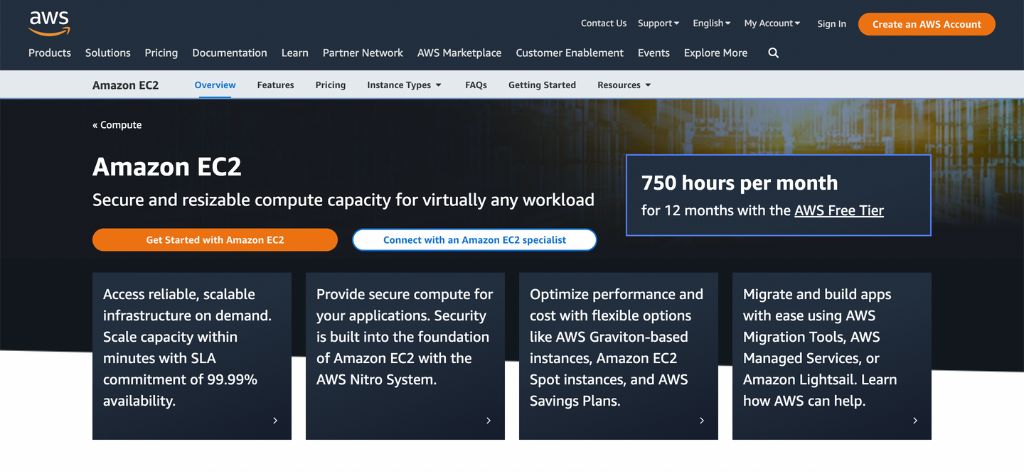
The two most common approaches to Amazon EC2 pricing are:
 Opt to use on-demand instances and then pay according to your usage amount.
Opt to use on-demand instances and then pay according to your usage amount.
 Use a savings plan of one to three years and reduce costs compared to on-demand AWS service.
Use a savings plan of one to three years and reduce costs compared to on-demand AWS service.
Costs also vary depending on what EC2 type you decide to use.

There are five categories of Amazon resources and media instances you could choose from:
General Purpose Instances: Great if you’re new to AWS cloud computing and looking for a wide balance between computing power, memory and storage. Suitable for most AWS workloads.
Compute Optimized Instances: Ideal for compute-intensive workloads that require higher computing power. These instances deliver high performance at a cost-effective price.
Memory-Optimized Instances: Ideal for memory-intensive workloads that are required to process large datasets at a very fast speed e.g. big data analytics or anyone running on Hadoop or Apache Spark.
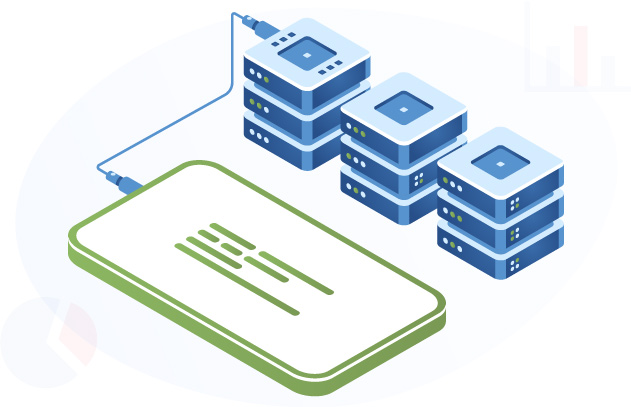
Accelerated Computing Instances: Ideal for applications that require parallel processing such as graphic processing, a floating-point aws pricing calculator or data pattern matching.
Storage Optimized Instances: If you have high storage requirements, this is the ideal instance for you.
- In particular, if you have sequential read-and-write resources and media applications (like log file processing), this instance is designed to deliver a high number of low-latency operations each second.
Once you decide on the right type of instance, there are a few different ways you can approach pricing. In all instances, prices vary according to the resources and media required and the hourly rate.

Since AWS resources offer more than 489 instances, that’s a lot of resources and media pricing factors for us to summarize. So instead, we’ll talk you through the common ways people choose to pay and how you can earn some sweet savings and discounts.
On-Demand Instances
On-demand resources and media instances allow you to turn them on at any time and only pay for the period you use them. These are priced per hour and can often cost fractions of a cent per hour.
If you stop the instance, you don’t have to pay for it anymore, though you may still need to pay for its storage. Considering you also don’t need to set up a physical server, on-demand instances also offer the most convenience.
Since there is such great flexibility available, the aws infrastructure can be the most expensive around but they get you started in less than a minute.
Reserved EC2 Instances
With a reserved instance, you can secure up to 75% off the cost of on-demand services. You need to reserve these instances for a specific length of time and typically, the longer the reservation period, the cheaper the resources and media costs.

You can start the reservation period for as little as 6 months or all the way up to 3 years. You can also choose to pay for the full period upfront or have a partial payment plan instead.
Spot Instances
If you want the cheapest pricing on Amazon EC2 services, spot instances can get up to 90% cheaper when compared to on-demand services.
Spot instances are the most complex ones to figure out the pricing of as they work similarly to the stock market.
The more people using spot instances, the more expensive your instance will be.
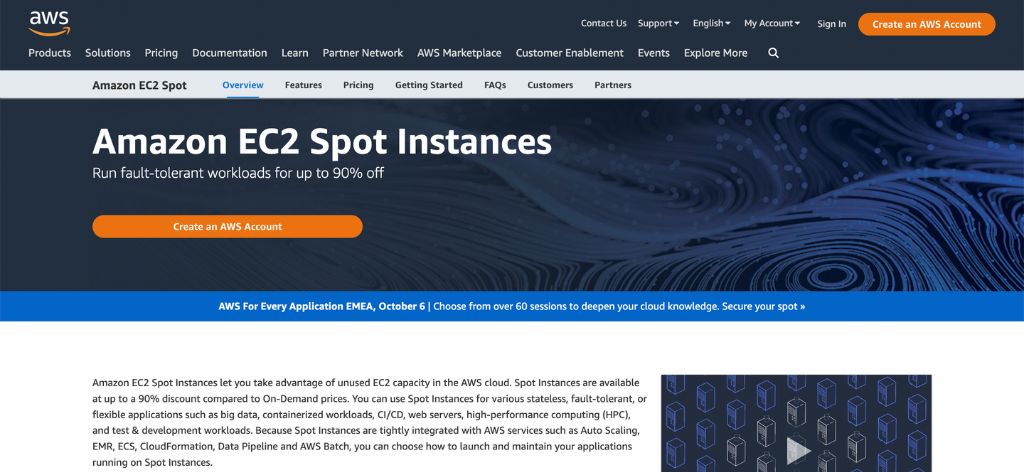
But, the reverse is also true, when fewer people are using spot instances on AWS, the cheaper your instance will be too.
You can also set the maximum price you’re willing to pay for resources for aws and Amazon will automatically run a server once an instance that fits your criteria becomes available.
We recommend spot instances for non-critical workloads as you can run them ad-hoc at any point in time.
It’s also worth noting that due to the price cap feature, Amazon can start and stop your resources and media instance at any point in time and such interruptions are not suitable for all types of projects.
However, if your project does not require 24/7 uptime, spot instances are the cheapest available by far.
Costs For AWS Databases
If you learn about us, you will realize that much like Amazon’s EC2 instances, pricing on databases varies depending on whether you choose a provisioned or on-demand resources and media option.
Pricing also varies depending on which database resources and media system you use.
DynamoDB Costs
DynamoDB is Amazon’s fully managed, serverless NoSQL database that’s designed to run high-performance applications at any scale you need.

Its on-demand pricing varies but here’s a starting idea:
Write request costs: $1.41 per million write requests
Read request costs: $0.28 per million read requests
You also need to pay for the storage of your database too. You can store up to 25GB of aws free tier per month.

Then, you’ll need to pay around 28 cents (USD) per extra GB. If you want to add extra services like backups, there will be additional costs for these too.
Let’s say you run 1 million writes and 1 million reads on a 30GB database, this would come to around $8.88 USD per month.
Storage: $7.50 USD/month
Writes: $1.25 USD/month
Reads: $0.13 USD/month
You can play around with Amazon’s DynamoDB on-demand calculator to get an accurate estimate of your use case.
MongoDB Costs
If you prefer using MongoDB instead, there is a fully-managed option available for AWS called MongoDB Atlas. While it offers a perpetual aws free tier, you will be sharing RAM and can only store as much as 512MB.
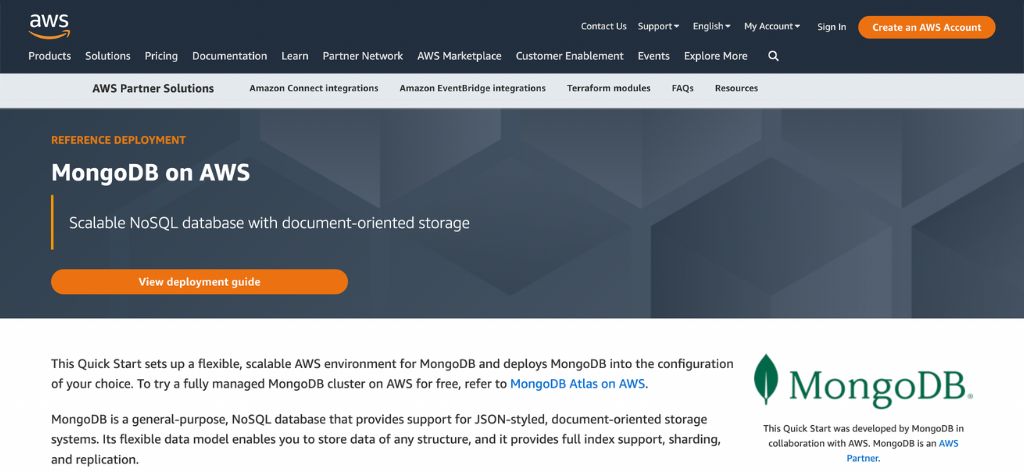
Usage-based pricing starts at only $9/month, however. For a more up-to-date estimate, check out MongoDB’s in-depth pricing page.
Static File Storage: Costs For Amazon S3
Amazon Simple Storage Service (S3) is perfect for anyone who is looking for static hosting for websites or applications that do not require server-side scripting.
Amazon S3’s pricing works a little differently as it is an Amazon cloud directory storage solution. Aws pricing calculator pricing is based on ‘buckets’ that can easily be configured to match your hosting use case.
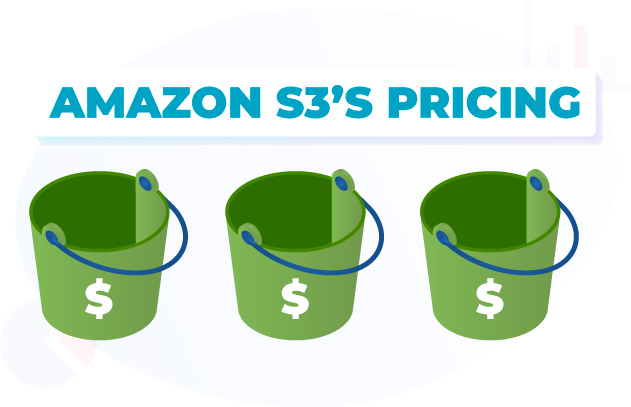
The costs are based on how much data you have stored, the frequency you need to access that data, and your overall monthly data transfers.
A major advantage of Amazon S3 is that there’s no need for any server admin as your bucket can automatically scale to serve any volume of traffic while maintaining fast page loading speeds.
Here are some of the costs for each type of S3 service.
S3 Standard
S3 Standard offers standard pricing for general-purpose storage. It’s best suited to any type of data that needs to be frequently accessed.
| S3 Standard Storage | Costs |
| First 50 TB/month | $0.023 / GB |
| Next 450 TB/month | $0.022 / GB |
| Over 500 TB/month | $0.021 / GB |
S3 Infrequent Access
All of Amazon’s Infrequent Access (IA) plans are cheaper than standard S3 buckets, however, the file retrieval cost is higher.
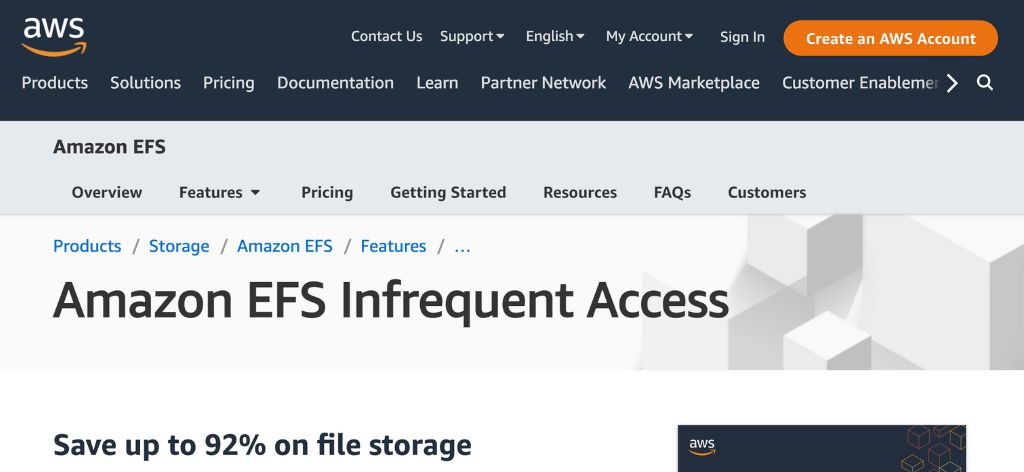
If you have files that do not need to be used often, this is a more suitable type of hosting plan in the AWS S3 suite. That being said, retrieving files is still fast.
| S3 Infrequent Access Storage | Costs |
| S3 Standard – Infrequent Access | $0.0125 / GB |
| S3 One Zone – Infrequent Access | $0.01 / GB |
S3 Glacier
Glacier is similar to the infrequent access plans above with even cheaper storage pricing but also more expensive retrieval costs.
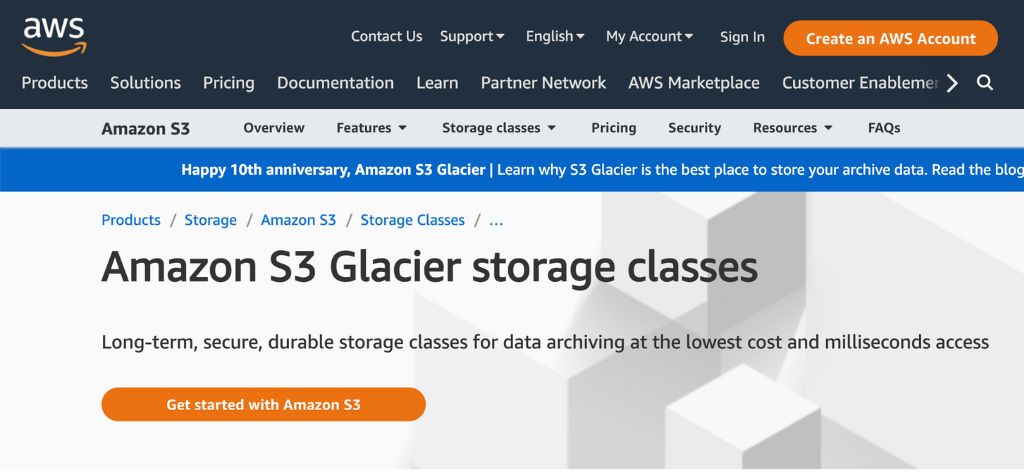
It’s ideal use case is for archiving files, most of which will likely not be retrieved again.
A typical example of this in action is the storage of files you might legally be required to keep.
As such, file retrieval is typically slower and can, at times, take hours to complete.
| S3 Glacier Storage | Costs |
| S3 Glacier Instant Retrieval | $0.004 / GB |
| S3 Glacier Flexible Retrieval (Formerly S3 Glacier) | $0.0036 / GB |
| S3 Glacier Deep Archive | $0.00099 / GB |
S3 Intelligent Tiering
S3 Intelligent Tiering lets Amazon automatically choose the best tier for your files.

It’s a system Amazon has developed to help users optimize their costs but it does come with an additional storage monitoring fee that none of the other types of S3 services have.
Here are some example costs for this service.
| S3 Intelligent – Tiering | Costs |
| Monitoring and Automation, All Storage / Month (Objects > 128 KB) | $0.0025 / 1,000 objects |
| Frequent Access Tier, First 50 TB / Month | $0.023 / GB |
| Frequent Access Tier, Next 450 TB / Month | $0.022 / GB |
| Frequent Access Tier, Over 500 TB / Month | $0.021 / GB |
| Infrequent Access Tier, All Storage / Month | $0.0125 / GB |
| Archive Instant Access Tier, All Storage / Month | $0.004 / GB |
AWS Amplify Pricing
AWS Amplify is a Backend as a Service (BaaS) solution that’s ideal for single-page web apps and static websites. It comes with a visual editor and a command line interface along with aws support for continuous development.
In short, it’s ideal for web apps that need ongoing development. AWS Amplify is designed to speed up and enhance the process of developers on AWS.
It also scales automatically according to how much traffic you’re getting and it does not sacrifice loading speed as it scales.
If you’re a beginner or a small team looking to try out a prototype, the AWS free tier may be all you need. It’s included as part of the AWS free tier which you can access for a full year with a few restrictions on how many resources and media you get as part of the AWS free tier.
Amazon resources and media also provide a couple of examples to help you better understand Amplify’s pricing depending on your use case.
Cost Breakdown & Variability
Ultimately, the costs of your AWS service will be flexible and depends on several resources and media factors.
Resources Required: Most of Amazon’s services are priced according to how many resources and media you use with the amount of storage and monthly data transfer setting the yardstick.
Type of Subscription: Not only does pricing vary between each of Amazon’s services but there are also different types of resources and media subscriptions and pricing models you can choose.
- For instance, on-demand aws pricing calculator tends to be the most flexible option but also the most expensive. You can save money by reserving instances for longer periods of time.
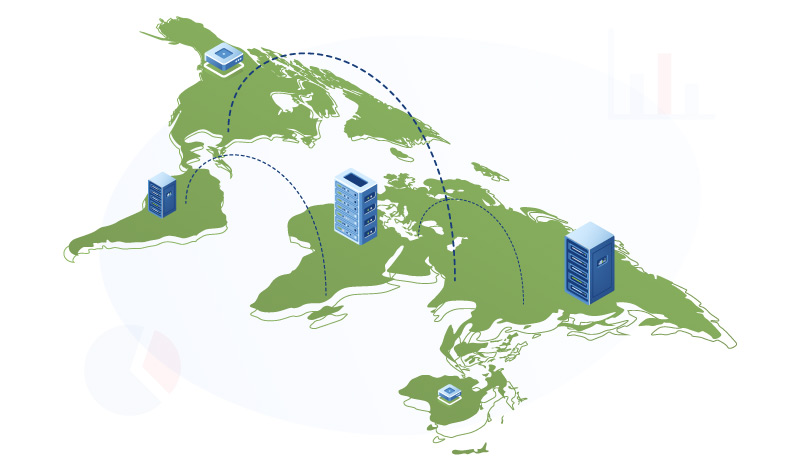
Data Center Location: The location of the data centers you use can also affect aws pricing calculator. Our price estimations are based on data centers in the US.
Support: AWS support covers all services, even unmanaged ones. However, if you need more advanced technical AWS support, you will need to factor in additional expenses starting at $29/month.
AWS Pricing Calculators
If you’re ever not sure what your tech stack resources and media requirements will cost using the AWS platform, check out the AWS calculator to help you get a price breakdown.
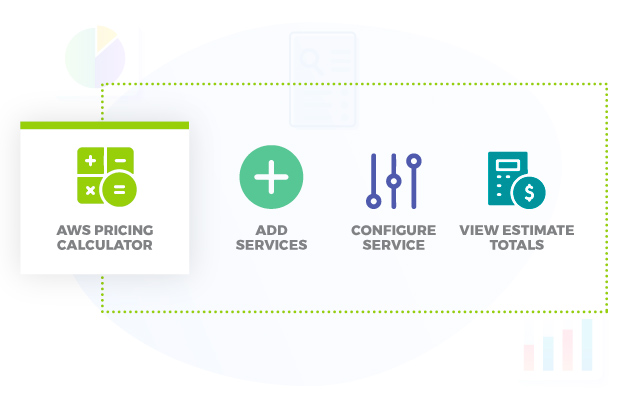
There are also other Amazon web services that offer similar estimations, such as CloudCraft.
Recommended Alternatives
If you’ve decided AWS is not the right solution for your needs, here are our top resources and media recommendations for alternatives.
Liquid Web offers extensive server management and very responsive support, both of which AWS does not offer without additional resources and media costs.
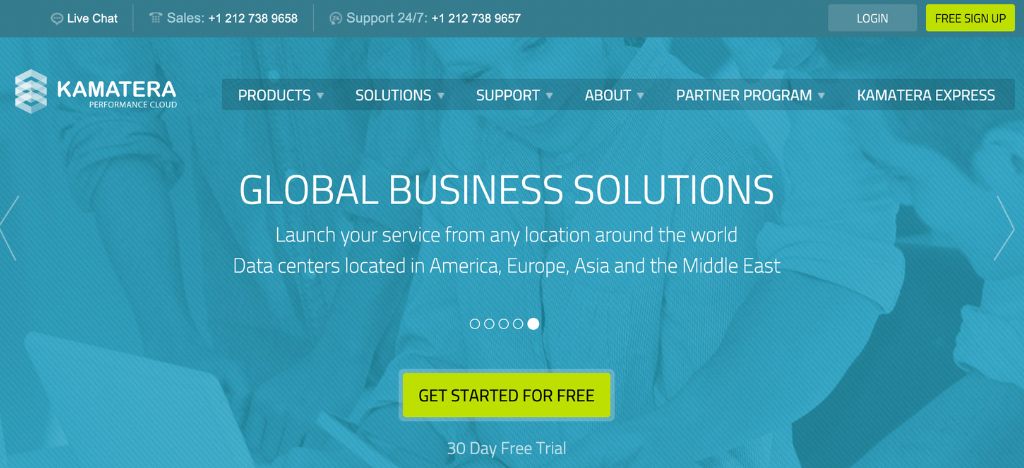
Kamatera allows you to build a custom cloud VPS solution at low prices and without having to commit years in advance to secure great deals.
Cloudways offers great managed cloud services which can utilize the AWS framework but without the headaches of having to configure your own servers.
Check out our guide on the best Amazon AWS alternatives to help you find the right cloud hosting platform for your needs.
Frequently Asked Questions (FAQS)
Which AWS Services Are Right For You?
The best AWS service for your project depends on what resources and media you need most.
For instance, if you need simple, static website hosting services for a landing page or website, Lightsail is a great option to explore.

Amazon S3 is better suited for file storage, especially for documents you do not need to access frequently.
What Are The Different Pricing Models For AWS?
Amazon offers pay-as-you-go pricing for most of its resources and media services. There are two exceptions with Lightsail being the only service with pre-defined plans and EC2 instances offering cheaper prices if you reserve them for a long period of time.
How Does AWS Price Its Storage Services?

Generally, AWS storage services are priced according to how many GB you store and access each month.
Amazon elastic block store (EBS) provides reliable and secure storage for your applications. With it, you can easily scale your storage, allowing you to store data from a few kilobytes to petabytes.
Amazon Elastic block store offers the highest levels of performance and cost-effective pricing. Plus, its security features protect your data from unauthorized access.
Is Amazon AWS Free?
Not quite. While there is the AWS free tier to consider, it is not a long-term free solution as most of the resources and media services on the AWS free tier expire after one year.
Summary Of AWS Costs You Can Expect Each Month
Amazon’s AWS pricing is more flexible than many other cloud hosting resources and media providers offer.
It’s designed to offer you the flexibility and scalability you need to build any type of application or website.
However, with such flexibility, you might find yourself spending more than you thought you would simply because you didn’t understand the pricing structure of the resources and media.
Pay-as-you-go pricing is the most expensive way to use AWS services so we recommend you do some forward planning to ensure you don’t get stuck with a bill higher than you expect!
For some AWS services, it may be more than what they need.
If you are a small business looking for a great web hosting solution check out our article 7 Best Web Hosting For Small Business: 2024‘s Top Providers.
 Opt to use on-demand instances and then pay according to your usage amount.
Opt to use on-demand instances and then pay according to your usage amount. Use a savings plan of one to three years and reduce costs compared to on-demand AWS service.
Use a savings plan of one to three years and reduce costs compared to on-demand AWS service.
